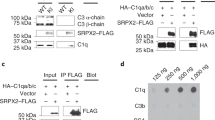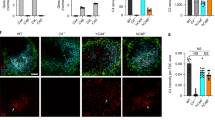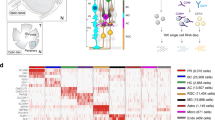Abstract
The efficient and selective removal of apoptotic cells is an important feature of tissue development, homeostasis and pathology. In the nervous system, synapses and distal axons are selectively eliminated as part of the remodelling that underpins development and pathology, through a process that has some features in common with apoptotic cell removal. Components of the complement cascade are implicated in the efficient removal of apoptotic cells outside the nervous system, and recent evidence suggests that the complement components C1q and C3 have a role in the selective tagging of supernumerary synapses in the developing visual system and in their efficient removal by as yet unidentified cells.
This is a preview of subscription content, access via your institution
Access options
Subscribe to this journal
Receive 12 print issues and online access
$189.00 per year
only $15.75 per issue
Buy this article
- Purchase on Springer Link
- Instant access to full article PDF
Prices may be subject to local taxes which are calculated during checkout



Similar content being viewed by others
References
Low, L. K. & Cheng, H. J. A little nip and tuck: axon refinement during development and axonal injury. Curr. Opin. Neurobiol. 15, 549–556 (2005).
Luo, L. & O'Leary, D. D. Axon retraction and degeneration in development and disease. Ann. Rev. Neurosci. 28, 127–156 (2005).
Perry, V. H., Hume, D. A. & Gordon S. Immunohistochemical localization of macrophages and microglia in the adult and developing mouse brain. Neuroscience 15, 313–326 (1985).
Conforti, L., Adalbert, R. & Coleman, M. P. Neuronal death: where does the end begin? Trends Neurosci. 30, 159–166 (2007).
Goddard, C. A., Butts, D. A. & Shatz, C. J. Regulation of CNS synapses by neuronal MHC class 1. Proc. Natl Acad. Sci. USA 104, 6828–6833 (2007).
Stevens, B. et al. The classical complement cascade mediates CNS synapse elimination. Cell 131, 1164–1178 (2007).
Botto, M. et al. Homozygous C1q deficiency causes glomerulonephritis associated with multiple apoptotic bodies. Nature Genet. 19, 56–59 (1998).
De Almeida, C. J. & Linden, R. Phagocytosis of apoptotic cells: matter of balance. Cell. Mol. Life Sci. 62, 1532–1546 (2005).
Bredesen, D. E., Rao, R. V. & Mehlen, P. Cell death in the nervous system. Nature 443, 796–802 (2006).
Trouw, L. A., Blom, A. M. & Gasque, P. Role of complement regulators in the removal of apoptotic cells. Mol. Immunol. 45, 1199–1207 (2008).
Arlaud, G. J. et al. Structural biology of the C1 complex of complement unveils the mechanism of its activation and proteolytic activity. Mol. Immunol. 39, 383–394 (2001).
Mollnes, T. E., Song, W. C. & Lambris, J. D. Complement in inflammatory tissue damage and disease. Trends Immunol. 23, 61–64 (2002).
Yi, J. J. & Ehlers, M. D. Ubiquitin and protein turnover in synapse function. Neuron 47, 5629–5632 (2005).
Cunningham, C. et al. Synaptic changes characterise early behavioural signs in the ME7 model of murine prion disease. Eur. J. Neurosci. 17, 2147–2155 (2003).
Jaubert-Miazza, L. et al. Structural and functional composition of the developing retinogeniculate pathway in the mouse. Vis. Neurosci. 22, 661–676 (2005).
Sanes, J. R. & Lichtman, J. W. Can molecules explain long-term potentiation? Nature Neurosci. 2, 597–604 (1999).
Mack, T. G. et al. Wallerian degeneration of injured axons and synapses is delayed by a Ube4b/Nmnat chimeric gene. Nature Neurosci. 4, 1199–1206 (2001).
Libby, R. T. et al. Inherited glaucoma in DBA/2J mice: pertinent disease features for studying the neurodegeneration. Vis. Neurosci. 22, 637–648 (2005).
Beazley, L. D., Perry, V. H., Baker, B. & Darby, J. E. An investigation into the role of ganglion cells in the regulation of division and death of other retinal cells. Brain Res. 430, 169–184 (1987).
Agrawal, A., Shrive A. K., Greenhough, T. J. & Volanakis, J. E. Topology and structure of the C1q-binding site on C-reactive protein. J. Immunol. 166, 3998–4004 (2001).
Xu, D. et al. Narp and NP1 form heterocomplexes that function in development and activity dependent synaptic plasticity. Neuron 39, 513–528 (2003).
O'Brien, R. J. et al. Synaptically targeted narp plays an essential role in the aggregation of AMPA receptors at excitatory synapses in cultured spinal neurons. J. Neurosci. 22, 4487–4498 (2002).
Sia, G.-M., Belque, J., Rumbaugh, G., Cho, R. & Worley, P. F. Interaction of the N-terminal domain of AMPA receptor GluR4 subunit with neuronal pentraxin NP1 mediates GluR4 synaptic recruitment. Neuron 55, 87–102 (2007).
Bjartmar, L. et al. Neuronal pentraxins mediate synaptic refinement in the developing visual system. J. Neurosci. 26, 6269–6281 (2006).
Gasque, P., Dean, Y. D., McGreal, E. P., VanBeek, J. & Morgan, B. P. Complement components of the innate immune system in health and disease in the CNS. Immunopharmacology 49, 171–186 (2000).
Kreutzberg, G. W., Graeber, M. B. & Streit, W. J. Neuron-glial relationship during regeneration of motorneurons. Metab. Brain Dis. 4, 81–85 (1989).
Svensson, M. & Aldskogius, H. Synaptic density of axotomized hypoglossal motorneurons following pharmacological blockade of the microglial cell proliferation. Exp. Neurol. 120, 123–131 (1993).
Kalla, R. et al. Microglia and the early phase immune surveillance in the axotimized facial motor nucleus: impaired microglial activation and lymphocyte recruitment but no effect on neuronal survival or axonal regeneration in macrophage-colony stimulating factor deficent mice. J. Comp. Neurol. 436, 182–201 (2001).
Sikorska, B., Liberski, P. P., Giraud, P., Kopp, N. & Brown, P. Autophagy is a part of ultrastructural synaptic pathology in Creutzfeldt–Jakob disease: a brain biopsy study. Int. J. Biochem. Cell Biol. 36, 2563–2573 (2004).
Ronnevi, L. O. Origin of glial processes responsible for the spontaneous postnatal phagocytosis of boutons on cat spinal motoneurons. Cell Tissue Res. 189, 203–217 (1978).
Halassa, M. M., Fellin, T. & Haydon, P. G. The tripartite synapse: roles for gliotransmission in health and disease. Trends Mol. Med. 13, 54–63 (2007).
Husemann J., Loike, J. D., Anankov, R., Febbraio, M. & Silverstein, S. C. Scavenger receptors in neurobiology and neuropathology: their role on microglia and other cells of the nervous system. Glia 40, 195–205 (2002).
Ronnevi, L. O. Spontaneous phagocytosis of C-type synaptic terminals by spinal α-motoneurons in newborn kittens. An electron microscopic study. Brain Res. 162, 189–199 (1979).
Bowen, S. et al. The phagocytic capacity of neurones. Eur. J. Neurosci. 25, 2947–2955 (2007).
Schraufstatter, I. U., Trieu, K., Sikora, L., Sriramarao, P. & DiScipio, R. Complement C3a and C5a induce different signal transduction cascades in endothelial cells. J. Immunol. 169, 2102–2110 (2002).
Bishop, D. L., Misgeld, T., Walsh, M. K., Gan, W. B. & Lichtman, J. W. Axon branch removal at developing synapses by axosome shedding. Neuron 44, 651–661 (2004).
Lobsiger, C. S., Boillée, S. & Cleveland, D. W. Toxicity from different SOD1 mutants dysregulates the complement system and the neuronal regenerative response in ALS motor neurons. Proc. Natl. Acad. Sci. USA 104, 7319–7326 (2007).
Acknowledgements
We thank J. Teeling for valuable discussions on the manuscript. Studies on synaptic degeneration in the authors' laboratories are supported by the Medical Research Council (UK).
Author information
Authors and Affiliations
Related links
Rights and permissions
About this article
Cite this article
Perry, V., O'Connor, V. C1q: the perfect complement for a synaptic feast?. Nat Rev Neurosci 9, 807–811 (2008). https://doi.org/10.1038/nrn2394
Published:
Issue Date:
DOI: https://doi.org/10.1038/nrn2394
This article is cited by
-
Myeloid deficiency of the intrinsic clock protein BMAL1 accelerates cognitive aging by disrupting microglial synaptic pruning
Journal of Neuroinflammation (2023)
-
Sex differences in immune gene expression in the brain of a small shorebird
Immunogenetics (2022)
-
Classical complement cascade initiating C1q protein within neurons in the aged rhesus macaque dorsolateral prefrontal cortex
Journal of Neuroinflammation (2020)
-
Microglia remodel synapses by presynaptic trogocytosis and spine head filopodia induction
Nature Communications (2018)
-
Errant gardeners: glial-cell-dependent synaptic pruning and neurodevelopmental disorders
Nature Reviews Neuroscience (2017)



